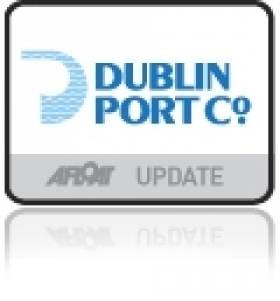Displaying items by tag: Minster for Transport
#SustainableReport - Dublin Port Company's first Sustainability Report was launched today by Minister for Transport, Tourism and Sport, Paschal Donohoe, TD.
The new report, to be published annually, provides an account of Dublin Port Company's sustainable development responsibilities, challenges and achievements from the previous year with regard to economic, environmental and social considerations.
The report documents the integrated approach that Dublin Port Company takes to facilitating the movement of passengers and goods through Ireland's largest, busiest port - servicing an economic need – balanced with the needs of the port's natural and built environment, and local communities it operates alongside.
At the launch of the new report, attended by customers and staff, local community groups, individuals, and elected representatives, Dublin Port Company and the Sustainable Energy Authority of Ireland (SEAI) also signed a joint energy efficiency agreement. As a member of the Public Sector Energy Partnership Programme, the agreement means that Dublin Port Company and SEAI will work in partnership to achieve a target of 33% energy efficiency savings and improvements by 2020.
Energy, Waste & Water Highlights 2013:
200,000 kWh of energy saved using a building management system installed at Port Centre in 2012; enough energy to power approximately 40 Irish homes for a year*
Almost 20,000 kWh generated from Dublin Port's first wind turbine installed in 2012, enough to power 6.2 houses per day
96% of waste recycled in 2013, compared to 40% in 2009
200,000m3 water consumed in 2013, compared to 400,000m3 in 2009
Metered water levels reduced to 26,553 m3 in 2013, compared to 260,000 m3 in 2009
95% reduction in water consumption achieved over four years by 2013 through elimination of leakages on the port's 260 hectare estate
Community Highlights 2013
Education scholarships were awarded to 34 local students in 2013, bringing to over 100 the number of people Dublin Port Company currently supports in higher education. Since the company's scholarship programme was founded in 2001, over 600 students have received financial support to pursue third level education courses.
Dublin Port Company also continued its support for Ringsend & District Response to Drugs (RDRD). The project works with families in challenging circumstances such as drug addiction, domestic violence, poverty and alcoholism. In 2013, the project provided support services to 228 families in the local community, a 28% increase on the 178 families it supported the previous year.
Biodiversity Highlights 2013
In 2013 Dublin Port Company embarked on a three-year Dublin Bay Birds project with BirdWatch Ireland, a new programme of waterbird monitoring and research. The project examines in greater detail how birds use Dublin Bay for feeding and roosting, while investigating their movements between Dublin Bay and neighbouring wetlands.
The 2013 highlights include the individual marking of 118 Oystercatchers with coded rings, bi-monthly waterbird counts and additional surveys, as well as the construction of a new temporary nesting site in the Tolka Estuary since colonised by the terns. Dublin Bay is one of Ireland's most important wetlands for migratory wintering waterbirds and holds the fourth largest breeding tern colony in Ireland.
Minister for Transport, Tourism and Sport, Paschal Donohoe, TD, said: "I am very pleased to launch Dublin Port Company's first Sustainability Report, given Dublin Port's status as a port of national significance and its contribution to the economic, environmental and social development of the country and our capital city. I welcome today's launch event and the publication of this report as a milestone in assisting individuals and organisations to further understand Dublin Port's significant role in this regard, and its future potential. It is important that ports take a holistic approach to their operations, including sustainable business practices, and I commend Dublin Port on its clear progress in this regard."
Eamonn O'Reilly, Chief Executive, Dublin Port Company, said: "Dublin Port Company is pleased to publish our first Sustainability Report. It provides an accessible account of the economic, environmental and social considerations that drive our approach to doing business more sustainably today, while shaping Dublin Port's future. We are committed to measuring and reporting on our activities as Dublin Port strives to facilitate economic growth, protect our environment and enrich the lives of local communities. The publication of a new Sustainability Report is further testament to Dublin Port Company's commitment."
Lucy McCaffrey, Chairperson, Dublin Port Company, said: "Dublin Port Company is dedicated to operating a sustainable port that is good for business, the city of Dublin and its citizens. It is imperative that we give an account of our stewardship and Dublin Port's journey to greater sustainability that will facilitate not only a thriving economy, but also a vibrant sea- and cityscape for this generation, and future generations to come. On behalf of Dublin Port Company, I thank Minister, Paschal Donohoe, TD for officially launching our first Sustainability Report today."
To read the report in full, download the report ny clicking HERE.























